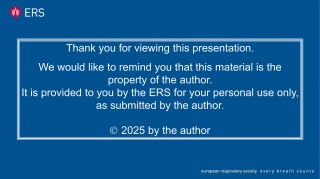20 March, 2025 | Online
17:00-18:00 CET
Chairs: Prof. Dr Michael Kreuter (Mainz, Germany), Dr Nazia Chaudhuri (Limavady, United Kingdom)
Speakers: Dr Lucile Sese (Paris, France), Dr Deborah Assayag (Montréal (QC), Canada), Dr Sheetu Singh (Jaipur (Rajasthan), India)
Fees: Free for ERS members / €10 for non-members
Find out more about becoming a member
Translation available
Participants in this webinar can benefit from translation during the live event. The translation function can be found underneath the live event's video player; up to 60 languages are available, with both subtitled and audio translation available. Please note that this is currently available for the live event only.
Learn more about this function.
Overview
The global impact of interstitial lung disease (ILD) is evident with the influence of environmental exposures on the risk and prevalence of ILD. This webinar brings together experts from around the world to discuss the global challenges of ILD and the need for equitable care across the globe.
Educational aims
- To highlight and describe the impact of air pollution and climate change on the incidence and prevalence of ILDs and the global impact of this.
- To discuss the racial disparities in healthcare and outcomes in interstitial lung disease.
- To discuss the global impact of environmental triggers and exposures on the incidence and prevalence of hypersensitivity pneumonitis - an Indian ILD specialist's perspective.
Topics:
- Climate change and its impact on interstitial lung diseases - Lucile Sese
- Racial disparities on healthcare and outcomes in interstitial lung disease - Deborah Assayag
- Hypersensitivity pneumonitis - an Indian ILD specialist's perspective compared to the rest of the world - Sheetu Singh
Format
One-hour webinar format: 45 minutes for presentations, followed by a 15-minute Q&A session.
Learning outcomes
Following this webinar, participants will be able to:
- Appreciate the impact of air pollution on incidence and prevalence of ILD and the importance of addressing climate change.
- Understand the impact that air pollution may have on exacerbations and disease progression.
- Understand and actively address the racial disparities in healthcare and outcomes related to ILD.
- Appreciate the important role of different antigens and variations in antigens that cause HSP globally.
CME credit
An application for accreditation of this webinar has been made to the European Board for Accreditation in Pneumology (EBAP) for 1 CME credit per 1-hour attendance. If accredited, the CME credit will be granted upon attendance of at least 60 minutes during the live webinar only.
What is a webinar?
A webinar closely simulates a lecture-based teaching experience. The speaker can interact with the audience, just as in a classroom setting. During the webinar, you will be asked to share your opinion on issues related to the topic using interactive polls.
All participants will be able to hear the lecturer and see the slides throughout the presentation. As a participant you will be able to pose questions or discuss ideas with the other participants via the text chat facility and the speaker will respond to the questions via the microphone.
Login guidelines
More information will be communicated in due course.
- Please log in to the webinar 20 minutes before it is scheduled to commence. If you have any technical difficulties whilst trying to log in or during the session please contact e-learning@ersnet.org.
- Check Central European Time.
- To achieve the best quality, we recommend to avoid downloading anything from the internet during your connection to the lecture and stopping all other programmes.
- Please also ensure that your audio settings are not set to mute and adjust the volume to a comfortable level.
Diseases/methods:
- Interstitial lung diseases
Target audience
- Clinicians
- Trainees
- Allied health professionals

